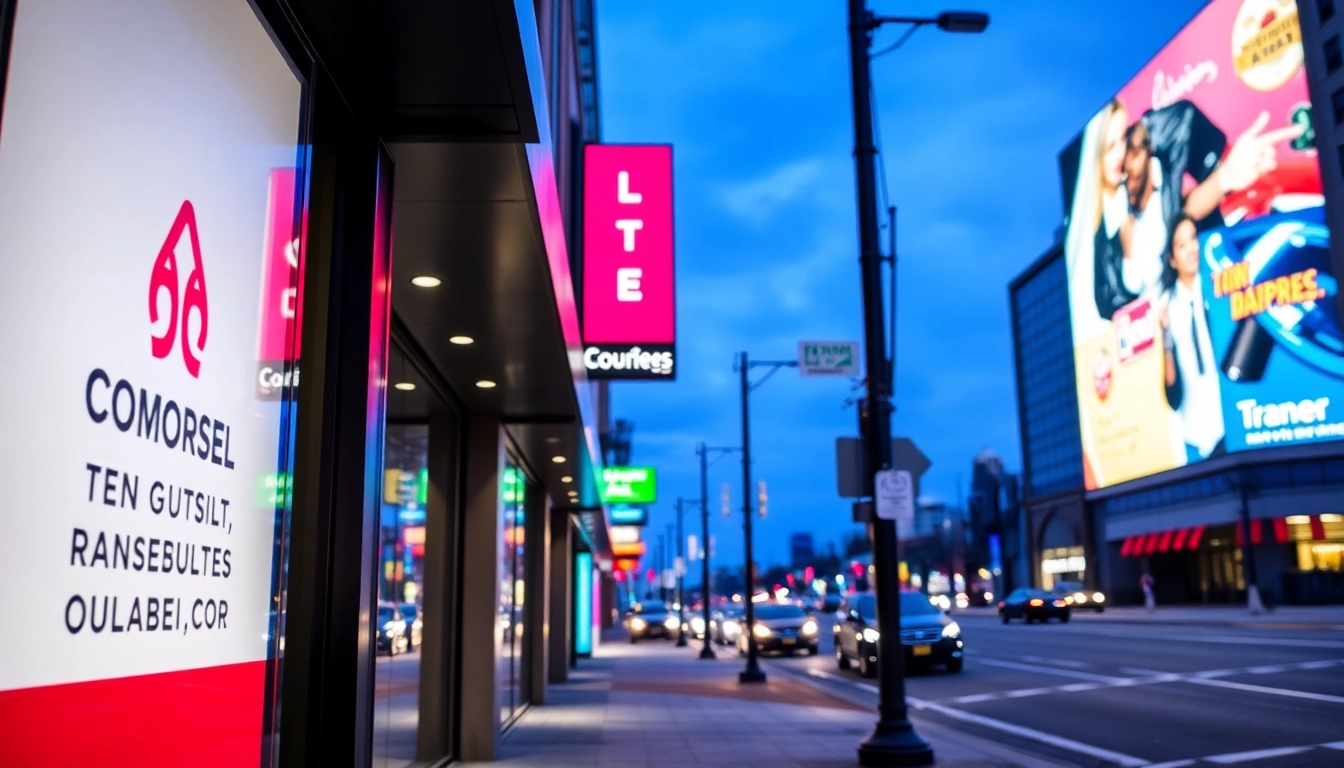The Ultimate Guide to Custom Signs: Elevating Your Business Visibility and Brand Identity
In today’s hyper-competitive marketplace, standing out is not just an advantage—it’s a necessity. Custom signs serve as vital tools to increase visibility, reinforce branding, and attract customers physically and visually. They are the silent ambassadors of your brand, working continuously even when you’re not actively promoting your business. Whether you operate a retail store, restaurant, healthcare facility, or any enterprise, utilizing high-quality, strategically designed custom signs can dramatically impact customer perceptions and bottom-line results. This comprehensive guide explores the myriad options, design principles, material choices, and innovative trends to help you harness the power of signage for business success.
Understanding the Power of Custom Signs in Business Branding
Importance of Custom Signs for Local Businesses
Custom signs are arguably the most effective form of outdoor advertising for local businesses. They provide immediate and tangible recognition, helping potential customers identify your location and understand what your business offers. According to recent studies, about 76% of consumers visit a store within five miles because of its signage, highlighting its influence on foot traffic and local inquiries. Custom signage acts as both a billboard and a brand statement, elevating perception and trustworthiness. Well-designed signs can also differentiate your business from competitors and strengthen community presence through consistent branding cues.
How Custom Signs Reinforce Brand Identity
Brand integrity hinges on visual consistency, and custom signs are integral to this process. They encapsulate your brand’s personality through the use of logos, color schemes, fonts, and messaging. For instance, a fast-food franchise’s bright, bold, and playful signage instantly communicates its fun, approachable brand identity, while a luxury hotel’s elegant, understated signage signals exclusivity and refinement. When your signage aligns with your overall branding strategy, it creates a cohesive customer experience that fosters loyalty and recognition. This alignment ensures that every impression—be it online or offline—unambiguously conveys your brand story.
Key Elements of Effective Signage Design
Design is the cornerstone of impactful signage. Effective signage balances aesthetics with functionality, ensuring visibility and readability. Critical design elements include:
- Clarity: Clear messages and minimal clutter help viewers grasp your message instantly.
- Contrast: Adequate contrast between text and background enhances readability, especially at night.
- Typography: Use bold, legible fonts that reflect your brand personality—sans-serif fonts for modernity; serif fonts for tradition.
- Color: Colors evoke emotions—blue conveys trust, red stimulates urgency. Use your brand colors strategically.
- Hierarchical Layout: Highlight key messages or calls-to-action through size, placement, or color.
Incorporating these elements with professional expertise guarantees a sign that not only attracts attention but also communicates efficiently.
Types of Custom Signs and Material Choices
Metal, Vinyl, and Plastic Sign Options
The choice of material profoundly influences your sign’s durability, appearance, and cost. Popular materials include:
- Metal Signs: Aluminum, brass, and steel signs exude professionalism and longevity. Aluminum, being lightweight and rust-resistant, is a popular choice for outdoor signage. Brass signs lend a classic, elegant touch.
- Vinyl Signs: Vinyls are versatile, cost-effective, and removable, making them ideal for temporary promotions or interior branding (like wall graphics and decals). They can be printed in vibrant colors and are easy to install.
- Plastic Signs: Options like acrylic and polycarbonate offer sleek profiles and are resistant to weathering. Acrylic, for example, provides a high-gloss finish suitable for modern interiors and retail displays.
Choosing Durable Materials for Indoor and Outdoor Use
Indoor signs require materials that complement aesthetics while maintaining longevity, such as acrylic or lightweight aluminum. Conversely, outdoor signs demand weather resistance; thus, metals with protective coatings or Vinyl wrapped with protective lamination are ideal. Consider environmental factors such as exposure to sunlight, rain, or temperature fluctuations when selecting materials. Properly choosing durable materials can prolong the lifespan of your signage, reducing replacement costs and maintaining professional appearance over time.
Custom Signs by Industry: Retail, Hospitality, Healthcare
Different industries have specific signage needs shaped by regulatory requirements, branding, and the customer journey:
- Retail: Eye-catching window decals, aisle signage, and point-of-sale displays help increase conversions and enhance shopping experiences.
- Hospitality: Elegant facade signs, room identifiers, and directional signage ensure guests navigate smoothly and feel welcomed.
- Healthcare: Clear, compliant safety and ADA signs are vital for accessibility, along with directional and informational signs that improve patient flow and safety.
Custom signs tailored for each industry maximize operational efficiency and brand consistency while complying with industry standards.
Designing Eye-Catching Custom Signs: Best Practices
Incorporating Brand Colors and Logos
Brand colors and logos are the cornerstone of recognition. Incorporate your logo prominently and use brand-specific color schemes universally, from your storefront signage to digital platforms. Consistency reinforces your identity and increases recall. For example, Coca-Cola’s signature red is instantly recognizable, which they leverage across all signage to maintain a unified brand presence.
Using Clear Typography for Maximum Readability
Typography impacts how easily your message is understood. Choose fonts that are legible at various distances and sizes. Sans-serif fonts, like Helvetica or Arial, are preferred for their clarity. Avoid overly decorative fonts which might impede readability, especially in low-light conditions or at high speeds (such as roadside signage). Use large type for critical messages, and limit the number of font styles to maintain visual coherence.
Balancing Visual Elements for Impact
Effective signs strike a harmonious balance between images, text, and negative space. Incorporate high-resolution graphics that resonate with your brand, but do not overpower the message. Use symmetry and alignment to create visual flow, guiding viewers’ eyes to critical information, such as your brand name or call-to-action. Professional design tools and consultations can optimize these elements for maximum impact.
Digital and Innovative Signage for Modern Businesses
LED and Digital Signs with Real-Time Updates
Modern digital signage offers unparalleled flexibility. LED signs and digital displays allow businesses to change messages instantly, showcasing special offers, upcoming events, or dynamic content tailored to time of day or audience. For example, retail stores can promote flash sales during peak hours, driving immediate traffic and sales.
Integrating Interactive Signage into Business Spaces
Interactive digital signage—touchscreens, kiosks, or QR code integration—creates engaging customer experiences. Healthcare facilities use interactive kiosks for check-in, while retail stores incorporate touch displays for product browsing. These features increase dwell time and foster deeper engagement, leading to higher conversion rates.
Enhancing Visibility with Motion and Light Effects
Motion lighting or animated content grabs attention in busy environments. Use light effects sparingly to emphasize key messages or branding elements. For example, animated entrances or scrolling text can be particularly effective in high-traffic areas or at night.
Implementing and Maintaining Custom Signs for Long-Term Success
Best Practices for Sign Placement and Placement Strategies
Proper placement is crucial to maximize visibility. Place signs at eye level and in high-traffic zones. For outdoor signs, consider sightlines from the road or sidewalk and ensure unobstructed views. Use lighting to illuminate signs at night and strategic placement to target your core customer demographics. Regularly reassess signage position based on customer flow and environmental changes.
Maintenance Tips to Keep Signs Vibrant and Clear
Routine cleaning and inspections ensure longevity. Clean exterior signs with mild soap and water, replacing burnt-out bulbs or damaged panels promptly. Protective coatings can help resist weathering and UV fading. For digital signs, regular software updates and hardware checks prevent technical issues. Document your maintenance schedule to extend the lifespan of your investments and maintain professional appearance.
Measuring Sign Effectiveness and ROI
Track performance metrics: increase in foot traffic, sales, and customer inquiries linked to signage. Use QR codes or personalized promos to measure engagement levels. Set clear goals and analyze data periodically to refine signage strategies. ROI can be gauged by comparing sales before and after signage deployment, combined with customer feedback and brand awareness surveys.



